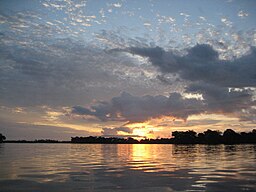 The Congo River (also known as Zaire River) is a river in Africa, and is the world's deepest river, with a measured depth of 230 m beyond (750 feet). It is the second largest river in the world by volume of water discharged, but only one fifth of the volume of the world's largest river, the Amazon. In addition, the total length of 4700 km (2,920 miles) makes it the longest river in the ninth.
The Congo River (also known as Zaire River) is a river in Africa, and is the world's deepest river, with a measured depth of 230 m beyond (750 feet). It is the second largest river in the world by volume of water discharged, but only one fifth of the volume of the world's largest river, the Amazon. In addition, the total length of 4700 km (2,920 miles) makes it the longest river in the ninth.Its catchment area covers 4014500 km square (1.55 million square miles). Congo, the discharge of his mouth varies from 23 000 cubic meters per second (810,000 cu ft / sec) 75 000 cubic meters per second (2.6 million cu ft / sec), with an average of 41 000 cubic meters per second (1.4 million cu ft / s).
The river and its tributaries across the Congo rainforest, the second largest rainforest in the world, surpassed only by the Amazon in South America. The river also flows the second largest in the world, behind the Amazon, the drainage area of a third river, behind the Amazon and the Rio Plata River, and is one of the deepest rivers in the world, at depths exceeding 230 m (750 ft.) Because large parts of the river system above and below the equator, its flow is stable, because there is always at least one section of the river is experiencing a rainy season.
The Congo gets its name from the ancient kingdom of Kongo, who inhabited the land in the river mouth. Democratic Republic of Congo and the Republic of Congo, two countries located along the banks of the river bearing his name. Between 1971 and 1997, the government of Zaire, known as the Zaire River.
Sources of Congo are the highlands and mountains of the East African Rift and Lake Tanganyika and Lake Mweru, which feed the river Lualaba, which then becomes the Congo below Boyoma Falls. Chambeshi River in Zambia is generally regarded as the source of the Congo, in accordance with accepted practice around the world use the longest side of the river, like the river Nile.
The Congo flows generally north of Kisangani just below the Boyoma falls, then gradually bends southwest, passing by Mbandaka, joining with the Ubangi River, and run in the Pool Malebo (Stanley Pool). Kinshasa (formerly Leopoldville) and Brazzaville are on opposite sides of the river to the pool where the river narrows and falls through a series of cataracts in deep canyons (collectively known as the Livingstone Falls), running in Matadi and Boma, and at sea in the small town of Muanda.
The Congo Basin is one of the physiographic sections of the largest province in mid-Africa, which in turn is part of the great physiographic division of the mass of Africans.
0 comments:
Post a Comment